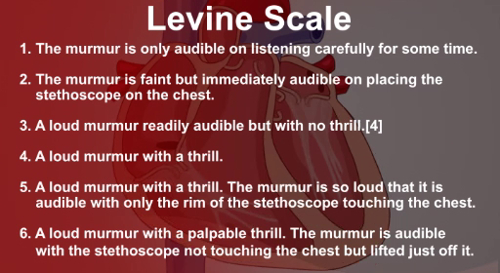Esame obiettivo del cuore III: suoni cardiaci anormali
Fonte: Suneel Dhand,MD, Medico curante, Medicina interna, Beth Israel Deaconess Medical Center
Avere una comprensione fondamentale dei normali suoni cardiaci è il primo passo verso la distinzione del normale dall'anormale. I mormorii sono suoni che rappresentano un flusso sanguigno turbolento e anormale attraverso una valvola cardiaca. Sono causati da stenosi (area della valvola troppo stretta) o rigurgito (riflusso di sangue attraverso la valvola) e sono comunemente sentiti come un suono "strisciante" durante l'auscultazione. I mormorii sono classificati da 1 a 6 di intensità (1 è il più morbido e 6 il più forte) (Figura 1). I soffi cardiaci più comuni sentiti sono i mormorii del lato sinistro delle valvole aortica e mitrale. I mormorii sul lato destro delle valvole polmonari e tricuspidi sono meno comuni. I mormorii sono tipicamente sentiti più forte nell'area anatomica che corrisponde alla patologia valvolare. Spesso, si irradiano anche in altre aree.

Figura 1. La scala levine utilizzata per classificare l'intensità del mormorio.
Oltre ai due principali suoni cardiaci, S1 e S2, che sono normalmente prodotti dalla chiusura delle valvole cardiache, ci sono altri due suoni cardiaci anormali, noti come S3 e S4. Questi sono anche noti come galoppi, a causa della natura "galoppante" di più di due suoni di fila. S3 è un suono acuto udito nella diastole precoce, causato dal sangue che entra nel ventricolo. S3 è un segno di insufficienza cardiaca avanzata, anche se può essere normale in alcuni pazienti più giovani. S4 si sente nella diastole tardiva e rappresenta il riempimento ventricolare dovuto alla contrazione atriale in presenza di un ventricolo rigido. S4 si sente anche nell'insufficienza cardiaca e nell'ipertrofia ventricolare sinistra.
1. Mormorii
- Posizionare il paziente con un angolo da 30 a 45 gradi sul tavolo d'esame.
- Quando si ausculta un soffio, chiedere al paziente di inspirare ed espirare, in quanto può fornire un indizio diagnostico vitale. I soffi sul lato destro (polmonari e tricuspidi) si sentono meglio sull'ispirazione, poiché il sangue scorre nel ventricolo destro quando la pressione intratoracica diminuisce. Al contrario, i mormorii sul lato sinistro si sentono meglio alla scadenza.
- Classificare i mormorii in
La capacità di riconoscere e distinguere tra i diversi soffi cardiaci si sviluppa con il tempo e la pratica. Il primo passo è identificare normale da anormale. Quando si sente un soffio, un esaminatore dovrebbe pensare alle seguenti domande: In quale parte del ciclo cardiaco si verifica - sistolico o diastolico? Dov'è il mormorio più forte? Dove si irradia il mormorio? È più forte sull'ispirazione o sulla scadenza?
Un esaminatore dovrebbe assicurarsi che l'ambiente sia tranquillo e che c...
Vai a...
Video da questa raccolta:

Now Playing
Esame obiettivo del cuore III: suoni cardiaci anormali
Physical Examinations I
91.1K Visualizzazioni

Approccio generale all'esame obiettivo
Physical Examinations I
115.2K Visualizzazioni

Osservazione e ispezione
Physical Examinations I
92.9K Visualizzazioni

Palpazione
Physical Examinations I
82.4K Visualizzazioni

Percussione
Physical Examinations I
99.2K Visualizzazioni

Auscultazione
Physical Examinations I
60.0K Visualizzazioni

Adeguamento corretto dell'abbigliamento del paziente durante l'esame obiettivo
Physical Examinations I
82.9K Visualizzazioni

Misurazione della pressione sanguigna
Physical Examinations I
106.8K Visualizzazioni

Misurazione dei segni vitali
Physical Examinations I
113.5K Visualizzazioni

Esame obiettivo dell'apparato respiratorio I: ispezione e palpazione
Physical Examinations I
155.6K Visualizzazioni

Esame obiettivo dell'apparato respiratorio I: percussione e auscultazione
Physical Examinations I
211.2K Visualizzazioni

Esame obiettivo del cuore I: ispezione e palpazione
Physical Examinations I
175.1K Visualizzazioni

Esame obiettivo del cuore II: auscultazione
Physical Examinations I
139.0K Visualizzazioni

Esame obiettivo della vascolatura periferica
Physical Examinations I
67.6K Visualizzazioni

Esame vascolare periferico utilizzando un Doppler a onda continua
Physical Examinations I
38.3K Visualizzazioni